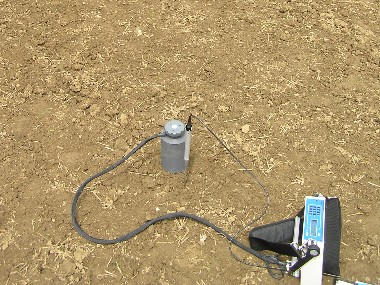Climate change scenario modelling of soil carbon turnover on basis of improved soil carbon pool distribution on a regional scale
 Project Leader: Prof. Dr. Georg Cadisch, Institute of Agricultural Sciences in the Tropics, Department of Plant Production in the Tropics and Subtropics
Project Leader: Prof. Dr. Georg Cadisch, Institute of Agricultural Sciences in the Tropics, Department of Plant Production in the Tropics and Subtropics
Cooperating Scientist: Prof. Dr. Torsten Müller, Institute of Crop Science, Department of Fertilisation and Soil Matter Dynamics
Funding period: 2015-2018
A high resolution representation of regional soil organic C (SOC) fluxes and pools facilitates an improved assessment of impacts of climate change and feedbacks on agro-ecosystems. However, soil organic carbon (SOC) pool partitioning in dynamic SOC models (i.e., DAISY) remains challenging, in particular when considering the driving influence of changing climatic conditions, e.g., by temperature sensitivities of individual SOC pools. The complexity of this constraint is magnified when SOC modelling is performed at a regional scale, where ecosystem and farm system heterogeneity exist.
We propose an improvement of the DAISY SOC turnover model in Phase 2 including the development of novel and generic SOC stability indexes for the two SOC pools SOM1 and SOM2 as well as the generation of a microbial pool partition index based on activities of microbial enzymes for SMB1 and SMB2 pool distinction also considering substrate utilisation efficiencies.
These essential steps will be primarily achieved through a further development of infrared (IR)-based techniques (diffuse reflectance mid-infrared Fourier transform spectroscopy (midDRIFTS), evolved gas analysis (EGA), in situT midDRIFTS, pyrolysis-MIRS) allowing a high-throughput, soil texture-independent analysis of SOC and microbial biomass pools at regional scale. Similar techniques will be employed to generate crop residue quality indexes for the two added organic matter pools AOM1 and AOM2 as initial regulators of C and N cycling.
To account for the projected impact of climate variability in the two model regions (Kraichgau, Swabian Alb), the SOC model will be furthered through explicit temperature functions for corresponding C and N pools. For calibration and validation of the dynamic SOC model, we will revert to the experimental field sites in the two model regions as well as considering our existing cooperations with international researchers at long-term field experiments.
Prior to coupling to the new Integrated Land-system Model System (ILMS) of FOR 1695, sensitivity analysis of individual and combined parameters related to the impact of expected regional climate with the advanced regional SOC model will be performed with DAISY-EXPERTN. The relevant developed and parameterised model routines and high resolution regional soil input maps will be incorporated into ILMS. In the final step, impacts of respective climate scenario analysis under alternative land uses, with and without improved CN module, on soil C dynamics and feedback from the atmosphere will be evaluated to derive recommendations for improved soil C sequestration approaches.
Phase 1: Coupling pyrolysis with mid-infrared spectroscopy for the parameterisation of soil carbon turnover models on a regional scale (funding period: 2012-2015)
